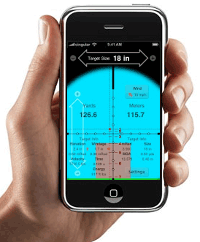Field Target Tip: How to Range Targets Using the Scope

This article appears courtesy Target Shooter magazine from the UK.
 Field Target (FT) and Hunter Field Target (HFT) airgun disciplines are popular outdoor shooting sports that simulate the challenges of hunting small game. One of the unique aspects of FT competition is target range-finding using parallax and optical focus. (HFT is limited to lower power scopes, so this type of range-fiding is not used in HFT.) Range-finding is very important because the pellets shot by FT airguns drop rapidly once they leave the muzzle (pellets can drop roughly 5″ at 50 yards). If you don’t have your scope set to the correct distance, you’ll probably miss the target high or low.
Field Target (FT) and Hunter Field Target (HFT) airgun disciplines are popular outdoor shooting sports that simulate the challenges of hunting small game. One of the unique aspects of FT competition is target range-finding using parallax and optical focus. (HFT is limited to lower power scopes, so this type of range-fiding is not used in HFT.) Range-finding is very important because the pellets shot by FT airguns drop rapidly once they leave the muzzle (pellets can drop roughly 5″ at 50 yards). If you don’t have your scope set to the correct distance, you’ll probably miss the target high or low.
FT competitors employ high-magnification (35-55X) scopes to sight targets placed from 10 to 55 yards (7.3 to 50m in the UK). Because these scopes have very short depth-of-field at high-magnification, the target will be out of focus unless you have the scope focus/parallax control set very precisely. But competitors can use this to their advantage — once the target is precisely focused, you have effectively established its distance from the shooter. FT scopes often have large-diameter wheels on the side parallax control so the focus can be set very precisely. You can then read marks placed on the scope to adjust the amount of elevation need to put the pellet on target.
To simplify the adjustment of elevation on FT rifles, competitors will place tapes on the windage knobs with marks that correspond to distances in 3-5 yard (or smaller) increments. These marks allow you to quickly spin your elevation to the setting matching the target range established with your focus/parallax control.
Field Target Accessories
There are a variety of specialized products for FT competitors that help you set up your scope for precise ranging. First, Compufoil offers a computer program, ScopeKnob, that lets you easily create accurate elevation knob tapes for your scope. ScopeKnob even comes with a built-in Ballistics Module that will calculate the pellet trajectory for you and plot range settings for your tape. Chairgun.com also offers ChairGunPRO, specialized airgun ballistics software that lets you simultaneously compare four different pellets, or different scope heights.
 In the past, the A-Team offered replacement elevation knobs optimized for use with yardage marking tapes. These were offered in two versions, one which replaced the existing turret altogether and a second which clamped OVER the factory turret. Shown at right is the larger-diameter version in place over the factory turret. Unfortunately we don’t know a current source for this product, but this may help you crate something similar on your own.
In the past, the A-Team offered replacement elevation knobs optimized for use with yardage marking tapes. These were offered in two versions, one which replaced the existing turret altogether and a second which clamped OVER the factory turret. Shown at right is the larger-diameter version in place over the factory turret. Unfortunately we don’t know a current source for this product, but this may help you crate something similar on your own.
Last but not least, Pyramid Air offers large-diameter parallax control wheels. According to Pyramid: “The enlarged sidewheel is the most popular FT scope accessory of all. It lets you put white artist’s tape around the rim to mark the actual distances at which the scope focuses”. A 6″ sidewheel provides over 18″ of space on which to inscribe yardage, and that means you can have a meaningful separation between 18 yards and 20 — where there is a huge parallax and trajectory difference. Though the ranges are already engraved on the rim of the wheel, field target competitors will measure them again on an actual range and write the markings on a strip of white artist’s tape.

Tips on Field Target Scope Set-Up
The creator’s of the A-Team knobs suggest taking your time when setting up a scope for Field Target competition: “We normally take from three to four hours preparing a scope to be mounted on a gun. We mark the scope in 1-yard increments from 9 to 40 yards, then to 55 yards by 3 or 5-yard increments depending on the scope being calibrated.”














 Leupold has just introduced a new second focal plane reticle with MOA-based hashmarks, allowing precise hold-overs and hold-offs (for wind). The new TS-32X1 reticle, is a minute-of-angle (MOA) based system designed to allow for precision shots without the need for dial adjustments. The TS-32X1 reticle is designed to work with riflescopes that employ 1/4-MOA target adjustments or M1 dials.
Leupold has just introduced a new second focal plane reticle with MOA-based hashmarks, allowing precise hold-overs and hold-offs (for wind). The new TS-32X1 reticle, is a minute-of-angle (MOA) based system designed to allow for precision shots without the need for dial adjustments. The TS-32X1 reticle is designed to work with riflescopes that employ 1/4-MOA target adjustments or M1 dials.
 Many of our readers are now using smart-phones for ballistic calculations. Now there is a new App for the iPhone which makes mildot target ranging simple and easy.
Many of our readers are now using smart-phones for ballistic calculations. Now there is a new App for the iPhone which makes mildot target ranging simple and easy. 





